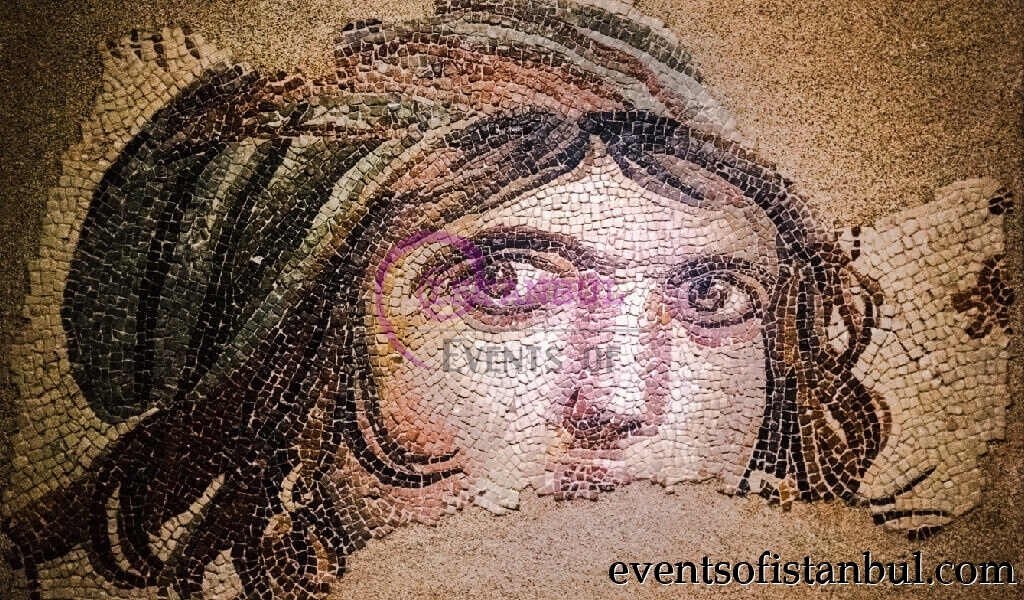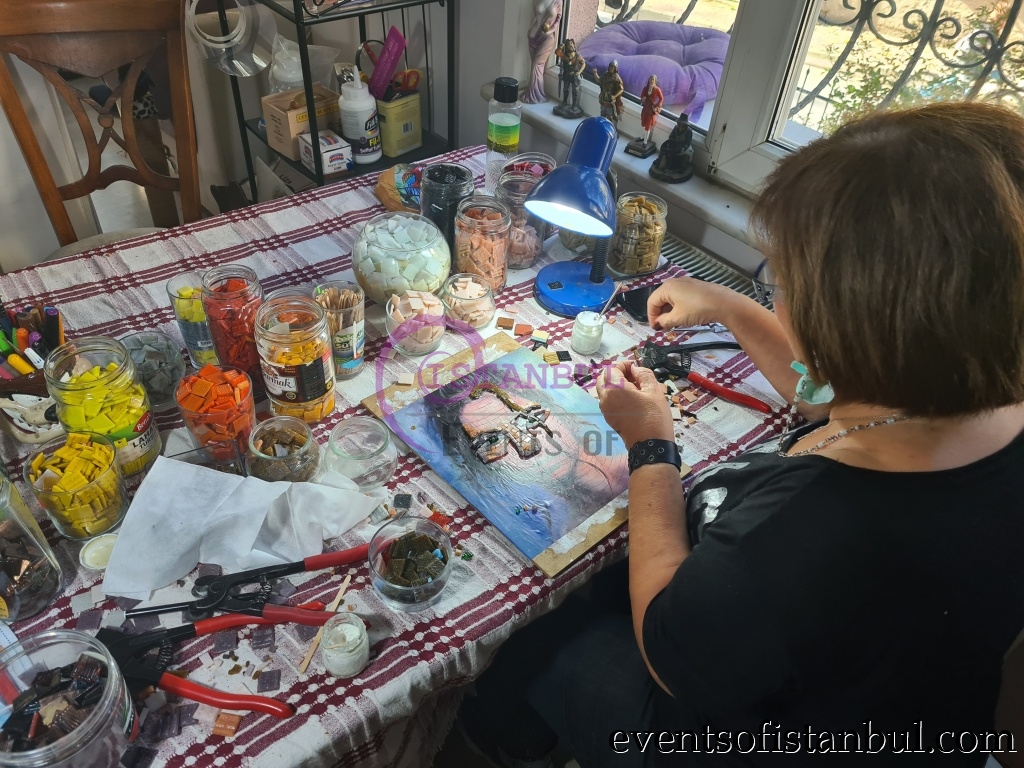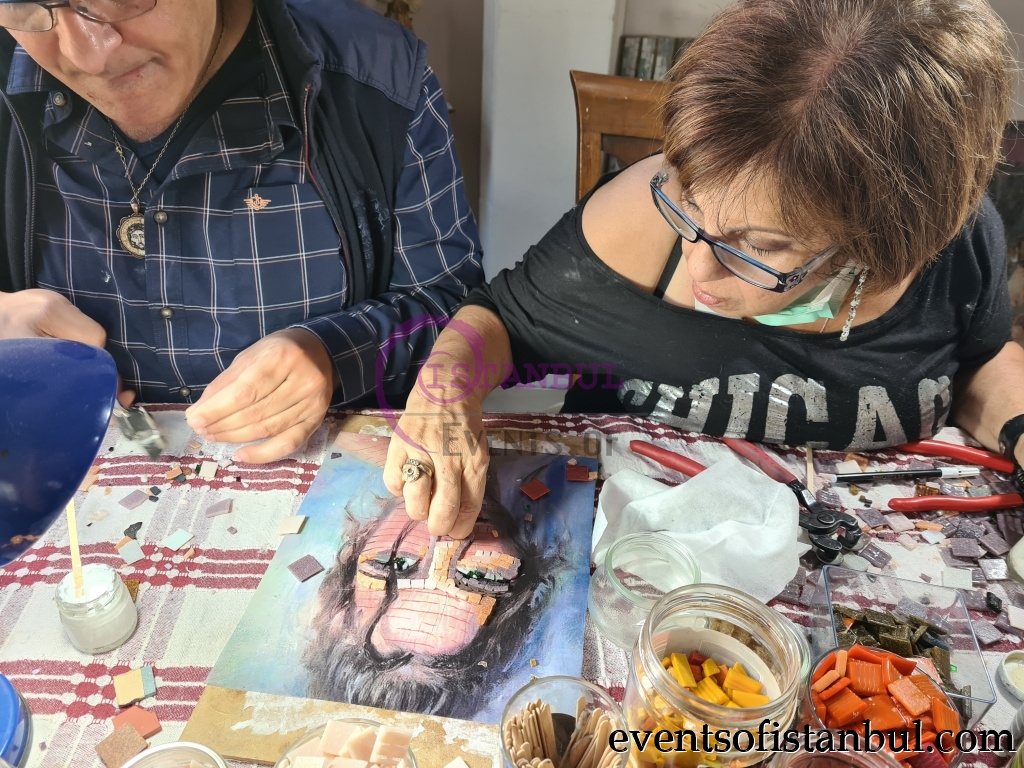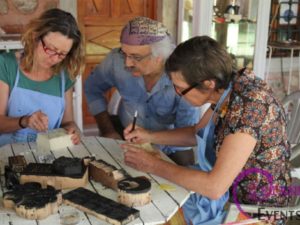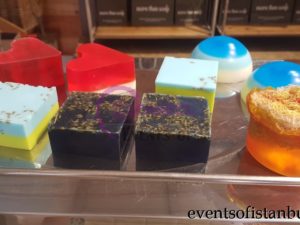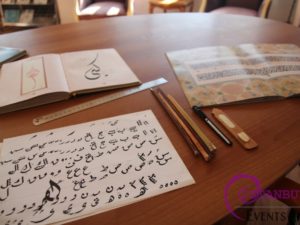Turkish Mosaic Workshop in Istanbul
135,00 EUR
Private or Group Classes Available All Year Long Everyday appointment !
Description
Turkish Mosaic Workshop in Istanbul
-
- Duration: 2 – 3 hours
- Location: Sultanahmet / ISTANBUL
- Lesson Teachings: available in English and Turkish
Overview ;
Turkish and Anatolian mosaics are worldwide famous with centuries of history in our lands. In our workshop, we try to give you information and teach you the techniques of this traditional art. Main princiapls are similar with painting but we use glass and natural stones. All around Anatolia, it is possible to come across the most beautiful examples of mosaic art made of fragments of tiles and pottery which, in history, was first applied the Sumerians 5000 years ago. In addition to the ancient Byzantine mosaics, Anatolia is also embellished the mosaics pertinent to the Islamic era. Islamic architecture used mosaic technique to decorate mosques and palaces since the Arabs conquered the eastern provinces of the Byzantine Empire in the 7th century. Our teachers are professional and experienced over 25 years on mosaic art. In this mosaic masterclass, we aim to teach you as mush as we can.What is Included ;
- In our lessons; we can teach beginner & advanced levels of Mosaic Art.
- Traditional Turkish style mosaic lesson with glass or natural stones.
- All equipments, cutters for the mosaic workshop.
- In the end of the workshop you will have a finished piece of art work.
- If you want, we can make multiple lessons to finish a bigger mosaic.
- Workshop Area, Aprons & Gloves
- Turkish Tea & Water
Meeting Point ;
Here is our Art Studio Address ;
Google Maps : https://goo.gl/maps/uXuyRmELZsx
Events of Istanbul – Les Arts Turcs Art Studio
Alemdar Mh. Incili Cavus St. No: 19 Floor : 3
(Behind The Underground Cistern) Sultanahmet 34110 Istanbul, Turkey
Contact : Mr. Alp or Mr. Nurdogan ( Phone : +90 544 220 10 22 )
E-mail : info@eventsofistanbul.com
Cancellation Policy ; Here in this link you can find the details about our cancellation policy.
Do you want to Order Mosaic Art ?
If you want, we are making custom made Mosaic art as wall panel or installments. For orders, please contact us ;
info@eventsofistanbul.com 00905442201022
Additional Information ;
Mosaic is an art of creating patterns and images with small, three dimension, coloured and uneven pieces of glass, pottery or stone.
We have an Art Studio in Sultanahmet area and our local teachers that are professional in Traditional Turkish Mosaics Masterclass. In our place, we give beginner, intermediate & advanced level of mosaic lessons. Usually lessons are 3 hours based and the end of 3 hours, you will be able to finish one art work.
History of Turkish and Anatolian Mosaics
A mosaic is a pattern or image made of small regular or irregular pieces of colored stone, glass or ceramic, held in place plaster/mortar, and covering a surface. Mosaics are often used as floor and wall decoration, and were particularly popular in the Ancient Roman world.
Mosaic today includes not just murals and pavements, but also artwork, hobcrafts, and industrial and construction forms.
Mosaics have a long history, starting in Mesopotamia in the 3rd millennium BC. Pebble mosaics were made in Tiryns in Mycenean Greece; mosaics with patterns and pictures became widespread in classical times, both in Ancient Greece and Ancient Rome. Early Christian basilicas from the 4th century onwards were decorated with wall and ceiling mosaics. Mosaic art flourished in the Byzantine Empire from the 6th to the 15th centuries; that tradition was adopted the Norman Kingdom of Sicily in the 12th century, the eastern-influenced Republic of Venice, and among the Rus in Ukraine. Mosaic fell out of fashion in the Renaissance, though artists like Raphael continued to practise the old technique. Roman and Byzantine influence led Jewish artists to decorate 5th and 6th century synagogues in the Middle East with floor mosaics.
Byzantine mosaics
The so-called Gothic chieftain, from the Mosaic Peristyle of the Great Palace of Constantinople
Mosaics were more central to Byzantine culture than to that of Western Europe. Byzantine church interiors were generally covered with golden mosaics. Mosaic art flourished in the Byzantine Empire from the 6th to the 15th centuries. The majority of Byzantine mosaics were destroyed without trace during wars and conquests, but the surviving remains still form a fine collection.
The great buildings of Emperor Justinian like the Hagia Sophia in Constantinople, the Nea Church in Jerusalem and the rebuilt Church of the Nativity in Bethlehem were certainly embellished with mosaics but none of these survived.
Important fragments survived from the mosaic floor of the Great Palace of Constantinople which was commissioned during Justinian’s reign. The figures, animals, plants all are entirely classical but they are scattered before a plain background. The portrait of a moustached man, probably a Gothic chieftain, is considered the most important surviving mosaic of the Justinianian age. The so-called small sekreton of the palace was built during Justin II’s reign around 565–577. Some fragments survive from the mosaics of this vaulted room. The vine scroll motifs are very similar to those in the Santa Constanza and they still closely follow the Classical tradition. There are remains of floral decoration in the Church of the Acheiropoietos in Thessaloniki (5th–6th centuries).
A pre-Iconoclastic depiction of St. Demetrios at the Hagios Demetrios Basilica in Thessaloniki.
In the 6th century, Ravenna, the capital of Byzantine Italy, became the center of mosaic making. Istria also boasts some important examples from this era. The Euphrasian Basilica in Parentium was built in the middle of the 6th century and decorated with mosaics depicting the Theotokos flanked angels and saints.
Fragments remain from the mosaics of the Church of Santa Maria Formosa in Pola. These pieces were made during the 6th century artists from Constantinople. Their pure Byzantine style is different from the contemporary Ravennate mosaics.
Very few early Byzantine mosaics survived the Iconoclastic destruction of the 8th century. Among the rare examples are the 6th-century Christ in majesty (or Ezekiel’s Vision) mosaic in the apse of the Church of Hosios David in Thessaloniki that was hidden behind mortar during those dangerous times. Nine mosaic panels in the Hagios Demetrios Church, which were made between 634 and 730, also escaped destruction. Unusually almost all represent Saint Demetrius of Thessaloniki, often with suppliants before him. This iconoclasm was almost certainly because of nearmuslim’s beliefs.
In the Iconoclastic era, figural mosaics were also condemned as idolatry. The Iconoclastic churches were embellished with plain gold mosaics with only one great cross in the apse like the Hagia Irene in Constantinople (after 740). There were similar crosses in the apses of the Hagia Sophia Church in Thessaloniki and in the Church of the Dormition in Nicaea. The crosses were substituted with the image of the Theotokos in both churches after the victory of the Iconodules (787–797 and in 8th–9th centuries respectively, the Dormition church was totally destroyed in 1922).
A similar Theotokos image flanked two archangels were made for the Hagia Sophia in Constantinople in 867. The dedication inscription says: “The images which the impostors had cast down here pious emperors have again set up.” In the 870s the so-called large sekreton of the Great Palace of Constantinople was decorated with the images of the four great iconodule patriarchs.
The post-Iconoclastic era was the heyday of Byzantine art with the most beautiful mosaics executed. The mosaics of the Macedonian Renaissance (867–1056) carefully mingled traditionalism with innovation. Constantinopolitan mosaics of this age followed the decoration scheme first used in Emperor Basil I’s Nea Ekklesia. Not only this prototype was later totally destroyed but each surviving composition is battered so it is necessary to move from church to church to reconstruct the system.
An interesting set of Macedonian-era mosaics make up the decoration of the Hosios Loukas Monastery. In the narthex there is the Crucifixion, the Pantokrator and the Anastasis above the doors, while in the church the Theotokos (apse), Pentecost, scenes from Christ’s life and ermit St Loukas (all executed before 1048). The scenes are treated with a minimum of detail and the panels are dominated with the gold setting.
Detail of mosaic from Nea Moni Monastery
The Nea Moni Monastery on Chios was established Constantine Monomachos in 1043–1056. The exceptional mosaic decoration of the dome showing probably the nine orders of the angels was destroyed in 1822 but other panels survived (Theotokos with raised hands, four evangelists with seraphim, scenes from Christ’s life and an interesting Anastasis where King Salomon bears resemblance to Constantine Monomachos). In comparison with Osios Loukas Nea Moni mosaics contain more figures, detail, landscape and setting.
Another great undertaking Constantine Monomachos was the restoration of the Church of the Holy Sepulchre in Jerusalem between 1042 and 1048. Nothing survived of the mosaics which covered the walls and the dome of the edifice but the Russian abbot Daniel, who visited Jerusalem in 1106–1107 left a description: “Lively mosaics of the holy prophets are under the ceiling, over the tribune. The altar is surmounted a mosaic image of Christ. In the main altar one can see the mosaic of the Exaltation of Adam. In the apse the Ascension of Christ. The Annunciation occupies the two pillars next to the altar.”[15]
The Daphni Monastery houses the best preserved complex of mosaics from the early Comnenan period (ca. 1100) when the austere and hieratic manner typical for the Macedonian epoch and represented the awesome Christ Pantocrator image inside the dome, was metamorphosing into a more intimate and delicate style, of which The Angel before St Joachim — with its pastoral backdrop, harmonious gestures and pensive lyricism — is considered a superb example.
The 9th- and 10th-century mosaics of the Hagia Sophia in Constantinople are truly classical Byzantine artworks. The north and south tympana beneath the dome was decorated with figures of prophets, saints and patriarchs. Above the principal door from the narthex we can see an Emperor kneeling before Christ (late 9th or early 10th century). Above the door from the southwest vestibule to the narthex another mosaic shows the Theotokos with Justinian and Constantine. Justinian I is offering the model of the church to Mary while Constantine is holding a model of the city in his hand. Both emperors are beardless – this is an example for conscious archaization as contemporary Byzantine rulers were bearded. A mosaic panel on the gallery shows Christ with Constantine Monomachos and Empress Zoe (1042–1055). The emperor gives a bulging money sack to Christ as a donation for the church.
The dome of the Hagia Sophia Church in Thessaloniki is decorated with an Ascension mosaic (c. 885). The composition resembles the great baptistries in Ravenna, with apostles standing between palms and Christ in the middle. The scheme is somewhat unusual as the standard post-Iconoclastic formula for domes contained only the image of the Pantokrator.
Mosaic of Christ Pantocrator from Hagia Sophia from the Deesis mosaic.
A mosaic from the Hagia Sophia of Constantinople (modern Istanbul), depicting Mary and Jesus, flanked John II Komnenos (left) and his wife Irene of Hungary (right), c. 1118 AD
There are very few existing mosaics from the Komnenian period but this paucity must be due to accidents of survival and gives a misleading impression. The only surviving 12th-century mosaic work in Constantinople is a panel in Hagia Sophia depicting Emperor John II and Empress Eirene with the Theotokos (1122–34). The empress with her long braided hair and rosy cheeks is especially capturing. It must be a lifelike portrayal because Eirene was really a redhead as her original Hungarian name, Piroska shows. The adjacent portrait of Emperor Alexios I Komnenos on a pier (from 1122) is similarly personal. The imperial mausoleum of the Komnenos dynasty, the Pantokrator Monastery was certainly decorated with great mosaics but these were later destroyed. The lack of Komnenian mosaics outside the capital is even more apparent. There is only a “Communion of the Apostles” in the apse of the cathedral of Serres.
A striking technical innovation of the Komnenian period was the production of very precious, miniature mosaic icons. In these icons the small tesserae (with sides of 1 mm or less) were set on wax or resin on a wooden panel. These products of extraordinary craftmanship were intended for private devotion. The Louvre Transfiguration is a very fine example from the late 12th century. The miniature mosaic of Christ in the Museo Nazionale at Florence illustrates the more gentle, humanistic conception of Christ which appeared in the 12th century.
The sack of Constantinople in 1204 caused the decline of mosaic art for the next five decades. After the reconquest of the city Michael VIII Palaiologos in 1261 the Hagia Sophia was restored and a beautiful new Deesis was made on the south gallery. This huge mosaic panel with figures two and a half times lifesize is really overwhelming due to its grand scale and superlative craftsmanship. The Hagia Sophia Deesis is probably the most famous Byzantine mosaic in Constantinople.
The Pammakaristos Monastery was restored Michael Glabas, an imperial official, in the late 13th century. Only the mosaic decoration of the small burial chapel (parekklesion) of Glabas survived. This domed chapel was built his widow, Martha around 1304–08. In the miniature dome the traditional Pantokrator can be seen with twelve prophets beneath. Unusually the apse is decorated with a Deesis, probably due to the funerary function of the chapel.
The Church of the Holy Apostles in Thessaloniki was built in 1310–14. Although some vandal systematically removed the gold tesserae of the background it can be seen that the Pantokrator and the prophets in the dome follow the traditional Byzantine pattern. Many details are similar to the Pammakaristos mosaics so it is supposed that the same team of mosaicists worked in both buildings. Another building with a related mosaic decoration is the Theotokos Paregoritissa Church in Arta. The church was established the Despot of Epirus in 1294–96. In the dome is the traditional stern Pantokrator, with prophets and cherubim below.
Mosaic of Theodore Metochites offering the Chora Church to Christ
The greatest mosaic work of the Palaeologan renaissance in art is the decoration of the Chora Church in Constantinople. Although the mosaics of the naos have not survived except three panels, the decoration of the exonarthex and the esonarthex constitute the most important full-scale mosaic cycle in Constantinople after the Hagia Sophia. They were executed around 1320 the command of Theodore Metochites. The esonarthex has two fluted domes, specially created to provide the ideal setting for the mosaic images of the ancestors of Christ. The southern one is called the Dome of the Pantokrator while the northern one is the Dome of the Theotokos. The most important panel of the esonarthex depicts Theodore Metochites wearing a huge turban, offering the model of the church to Christ. The walls of both narthexes are decorated with mosaic cycles from the life of the Virgin and the life of Christ. These panels show the influence of the Italian trecento on Byzantine art especially the more natural settings, landscapes, figures.
The last Byzantine mosaic work was created for the Hagia Sophia, Constantinople in the middle of the 14th century. The great eastern arch of the cathedral collapsed in 1346, bringing down the third of the main dome. By 1355 not only the big Pantokrator image was restored but new mosaics were set on the eastern arch depicting the Theotokos, the Baptist and Emperor John V Palaiologos (discovered only in 1989).
In addition to the large-scale monuments several miniature mosaic icons of outstanding quality was produced for the Palaiologos court and nobles. The loveliest examples from the 14th century are Annunciation in the Victoria and Albert Museum and a mosaic diptych in the Cathedral Treasury of Florence representing the Twelve Feasts of the Church.
In the troubled years of the 15th century the fatally weakened empire could not afford luxurious mosaics. Churches were decorated with wall-paintings in this era and after the Turkish conquest.
Mosaic was widely used on religious buildings and palaces in early Islamic art, including Islam’s first great religious building, the Dome of the Rock in Jerusalem, and the Umayyad Mosque in Damascus. Mosaic went out of fashion in the Islamic world after the 8th century.
Modern mosaics are made artists and craftspeople around the world. Many materials other than traditional stone, ceramic tesserae, enameled and stained glass may be employed, including shells, beads, charms, chains, gears, coins, and pieces of costume jewelry.
The unique mosaics from the Roman and Byzantine Empires, which survived the historical events and natural disasters, are today on display in major museums of Turkey.
The world’s two biggest mosaic museums are found in Turkey. If you believe that the valuable things come in small parcels then be sure to visit the mosaic museums.
Also two of these museums are still the world’s largest mosaic museums.
- Zeugma Mosaic Museum, Gaziantep
- Hatay Archaeological Museum, Hatay
- Great Palace Mosaics Museum, Istanbul
- Hagia Sophia Church, Istanbul
- Chora Museum, Istanbul
- Misis Mosaic Museum, Adana
- Haleplibahce Mosaic Museum, Sanliurfa
